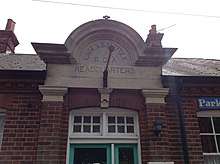Suffolk Artillery Volunteers
The Suffolk Artillery Volunteers were formed in 1860 as a response to a French invasion threat.[1] They became part of the Territorial Force in 1908 and served during the First and Second World Wars until the abolition of Coast Artillery in 1956.
| Suffolk Artillery Volunteers | |
|---|---|
| Active | 1899–1956 |
| Country | |
| Branch | |
| Type | Artillery |
| Role | Garrison Artillery Coast Artillery |
| Garrison/HQ | Harwich |
Artillery Volunteers 1861–1908
The 1st Suffolk Artillery Volunteer Corps was formed at Lowestoft on 10 July 1860 and was followed by three more (one being disbanded in 1871). When the Volunteer Force was reorganised in 1880 the three surviving Suffolk batteries (located at Lowestoft, Beccles and Aldeburgh) were consolidated as part of the 1st Norfolk Artillery Volunteers. They went on to form the III East Anglian (Howitzer) Brigade in the Royal Field Artillery during World War I.[2][3][4]
In 1899, four newly-raised Suffolk batteries (three at Ipswich and one at Felixstowe) were combined with two batteries from the 1st Essex Artillery Volunteers at Harwich to create a new Corps, designated as the 1st Suffolk and Harwich Artillery Volunteers.[3]
Territorial Force 1908–1920

In 1908 on the formation of the Territorial Force the unit became a defended ports unit - the Essex and Suffolk Royal Garrison Artillery (TF). Three companies were provided by the Suffolk section of the Corps and five companies from the Essex section. It served at home during World War I and was placed in suspended animation in 1919.[5]
Interwar years
After the war, the units were reconstituted as the Essex Coast Brigade RGA (TA) with headquarters at York Road, Southend-on-Sea from 1924.[6] and the Suffolk Coast Brigade RGA (TA) In 1938 the latter was designated the Suffolk Heavy Regiment RA (TA).[7]
Second World War
In 1940 the unit was re-organised as 514th Coast Regiment RA (TA) with headquarters at Lowestoft (Felixstowe after 1942). It was placed in suspended animation in 1946.
Another unit - 515th Coast Regiment RA (TA) was raised in 1940 from part of the re-organised Suffolk Heavy Regiment, with Headquarters at Harwich.
In 1947 the unit was reconstituted as 419th Coast Regiment RA (Suffolk)(TA). In 1956 on the disbandment of Coast Artillery it was amalgamated with 358th (Suffolk Yeomanry) Field Regiment RA (TA) to form 358th (Suffolk Yeomanry) Field Regiment RA (TA).
Notes
- Beckett.
- Beckett, Appendix VIII.
- Litchfield and Westlake, p. 156
- Litchfield, p. 217.
- Litchfield, p. 65.
- Osborne, p. 232
- Litchfield, p. 220
References
- Ian F.W. Beckett, Riflemen Form: A Study of the Rifle Volunteer Movement 1859–1908, Aldershot, Army Museums Ogilby Trust, 1982, ISBN 0-85936-271-X.
- Litchfield, Norman E H, and Westlake, R, 1982. The Volunteer Artillery 1859–1908, The Sherwood Press, Nottingham. ISBN 0-9508205-0-4
- Litchfield, Norman E H, 1992. The Territorial Artillery 1908–1988, The Sherwood Press, Nottingham. ISBN 0-9508205-2-0
- Osborne, Mike, 2006. Always Ready: The Drill Halls of Britain's Volunteer Forces, Partizan Press, Essex. ISBN 1-85818-509-2